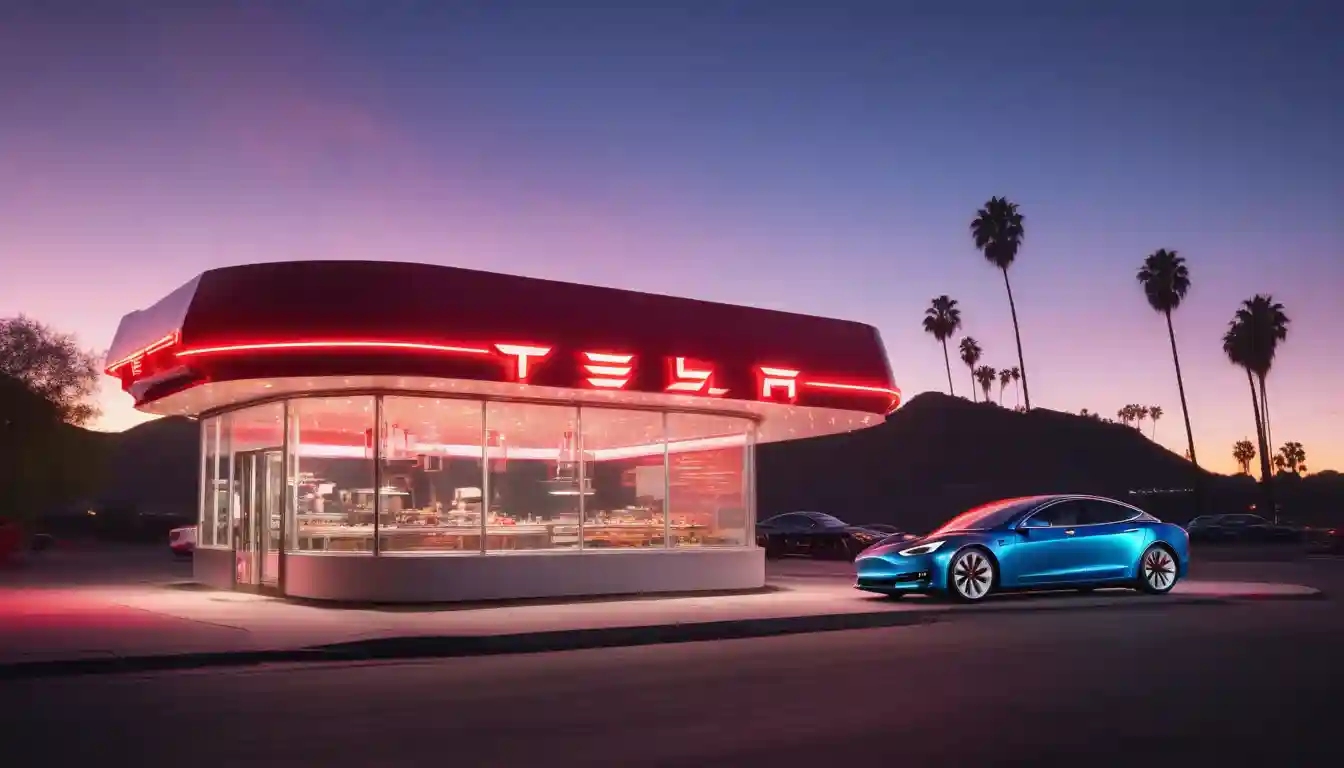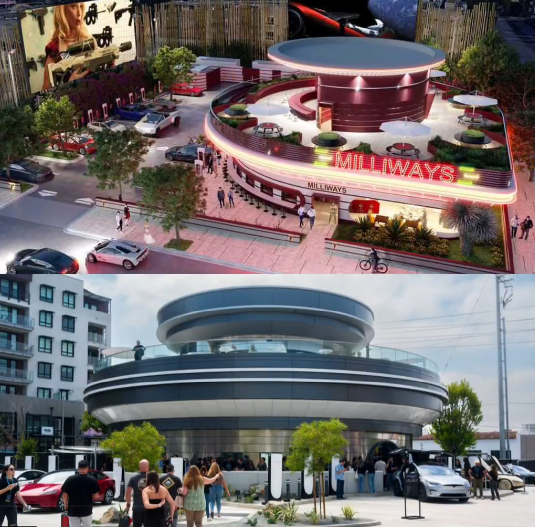
Tesla Opens First Robot-Staffed Supercharger Diner with Drive-In Movies in Hollywood
Tesla's Supercharger Diner Debut: Retro Meets Robot in Hollywood's Newest Tech-Food Fusion
Where classic American drive-in culture meets EV future and humanoid service
In the heart of Hollywood, on a stretch of Santa Monica Boulevard where restaurants have come and gone, Tesla's long-anticipated "Supercharger Diner" quietly began trial operations this week. The gleaming retro-futuristic establishment isn't just another charging station with snacks—it represents a calculated strategic bet that could reshape both transportation infrastructure and food service economics.

Robots, Movies, and Milkshakes: Inside Tesla's New Destination
Under the glow of two massive 45-foot LED screens displaying curated film clips, Tesla owners now pull into charging stalls at 7001 W. Santa Monica Blvd., where they can order burgers and shakes directly from their vehicle's touchscreen. What arrives next might surprise even the most tech-savvy Angelenos: Tesla's Optimus humanoid robot, making its public debut as a popcorn server.
"The convergence of charging infrastructure with experiential dining creates something entirely new," notes a restaurant technology analyst visiting the site. "This isn't just about feeding people who happen to be charging—it's about creating a destination people specifically seek out."
The 24/7 operation marries several concepts Elon Musk first teased in 2018: a 1950s-inspired aesthetic complete with roller-skating servers, classic American comfort food overseen by renowned chef Eric Greenspan, and a drive-in theater experience visible from both the parking area and rooftop seating.
During a recent visit, Musk himself shared video of the space on social media, calling it "one of the coolest spots in LA." The development represents far more than a quirky side project for the Tesla CEO—it's the culmination of years of planning, with construction beginning in 2023 on the site of a former restaurant acquired below comparable market prices.
Beyond Novelty: The Economics of Destination Charging
Tesla's Hollywood experiment comes at a critical moment for the automotive industry. With EV demand growth slowing and margins under pressure from price wars and rising component costs, the company is eyeing new revenue streams.
The financial calculation appears straightforward: EV drivers typically spend 15-60 minutes at fast-charging locations, creating a captive audience with demonstrated willingness to spend approximately $1 per minute while plugged in, according to industry data.
With 75 V4 Supercharger stalls at the Hollywood location, Tesla could generate between $3.3 million and $5.5 million in annual EBIT (earnings before interest and taxes) from the site alone, based on conservative estimates of charging sessions and food purchases.
Food and beverage operations offer gross margins exceeding 45% in U.S. convenience foodservice—substantially higher than Tesla's current automotive gross margin of less than 20%. The deployment of Optimus robots could further enhance profitability by reducing labor costs to below 10% of sales, compared to the quick-service restaurant industry average of approximately 28%.
Industry Shift or Elon's Folly?
Tesla isn't alone in exploring automotive-hospitality fusion. Aston Martin has entered high-end hospitality with exclusive residences and branded hotels. Hyundai briefly operated "Hotel Hyundai," showcasing its vehicle-to-load capabilities. Mercedes-Benz is building premium lounge-style charging hubs, while BP Pulse plans EV charger and convenience store remodels across 300 sites.
"This is not about burgers or fries," explains an industry observer monitoring the trend. "It's another front in the battle for data, mindshare, and customer lifetime value. Cars are now platforms, and platforms need ecosystems."
Yet significant risks remain. Tesla's abrupt firing of its Supercharger team in 2024 slowed network expansion and complicated partner relationships. Food quality inconsistencies could damage the brand, while the high capital expenditure required for rooftop decks and LED walls demands consistent utilization to generate returns.
The Investment Angle: What's at Stake
For investors, the Hollywood diner offers minimal immediate financial impact but substantial option value. If successful, the prototype could validate a model for nationwide expansion, potentially adding $1 billion in EBIT from 200-300 similar locations—representing just 4% of Tesla's projected global charging stations.
More significantly, commercial deployment of Optimus robots provides proof-of-concept for the humanoid's viability in service settings, critical for Tesla's ambitions in the projected $5 trillion humanoid market.
The diner also creates potential partnership opportunities with mall REITs, travel-plaza operators, and hotel chains seeking EV expertise alongside high-traffic real estate. The two massive LED screens establish new advertising inventory entirely within Tesla's ecosystem.
Key metrics investors should track include energy throughput per stall compared to system averages, food attachment rates per charging session, average ticket size, non-charging customer visits, and utilization patterns after the novelty effect subsides.
Strategic Chess Move or Distraction?
Tesla's Hollywood diner experiment represents a carefully engineered real-world testing ground. If the company achieves its base-case economics and demonstrates Optimus as a viable labor alternative, the concept becomes scalable—potentially transforming industry understanding of charging network valuation.
"Tesla's in-car ordering advantage is difficult for competitors to replicate quickly," notes a technology investment advisor. "The integration creates a seamless experience competitors will struggle to match without deep software partnerships."
For real estate investors, Tesla's likely pursuit of joint ventures or revenue-sharing models to accelerate rollout presents opportunity. Properties with EV-dense customer bases should consider early discussions as the concept proves viable.
The Hollywood Supercharger Diner isn't merely about selling popcorn—it's about monetizing time, experience, and loyalty in an increasingly competitive EV landscape where differentiation beyond the vehicle itself may determine long-term success.
As one analyst summarized: "Consider this a call option on three overlapping trends—EV charging monetization, humanoid labor deployment, and experiential branding. The option remains speculative but with visible catalysts approaching in the next 6-12 months."
Investment Thesis
| Category | Key Takeaways |
|---|---|
| Strategic Purpose | Tesla’s Hollywood Supercharger Diner is a prototype for high-margin "destination charging," combining EV charging with foodservice, Optimus robotics, and brand experience to defend ecosystem lock-in amid EV commoditization. |
| Financial Potential | Base case: USD 3-5m EBIT/year per site (75 stalls). Payback <3 years on ~USD 10m capex. Scalable to 200–300 sites (USD 1bn+ EBIT). |
| Key Moats | 1) Proprietary real-estate data from Supercharger network. 2) In-car OS payments/ordering. 3) Optimus labor cost reduction. 4) Social-media "brand theatre." |
| Risks | - Execution (Supercharger team instability). - Brand dilution (viral service failures). - Capex creep (LEDs/premium build). - Regulatory hurdles (foodservice rules). - Competition (BP, Mercedes, etc.). |
| Competitive Landscape | Tesla uniquely targets mass-premium throughput. Competitors (BP, Porsche, Hyundai) lack integrated F&B or scale. |
| Investment Implications | - TSLA Equity: Option value on charging/Optimus monetization. - Real Estate: JV opportunities for landlords. - F&B/Robotics: Optimus success could disrupt labor models. - OEMs: Tesla’s in-car UX is hard to replicate. |
| Catalysts to Watch | 1) Charging stall utilization vs. average. 2) F&B attach rates. 3) Optimus labor cost savings. 4) Non-charging footfall. 5) Capex efficiency in rollouts. |
Investors should note that past performance does not guarantee future results. All projections represent informed analysis rather than predictions. Readers should consult financial advisors for personalized investment guidance.